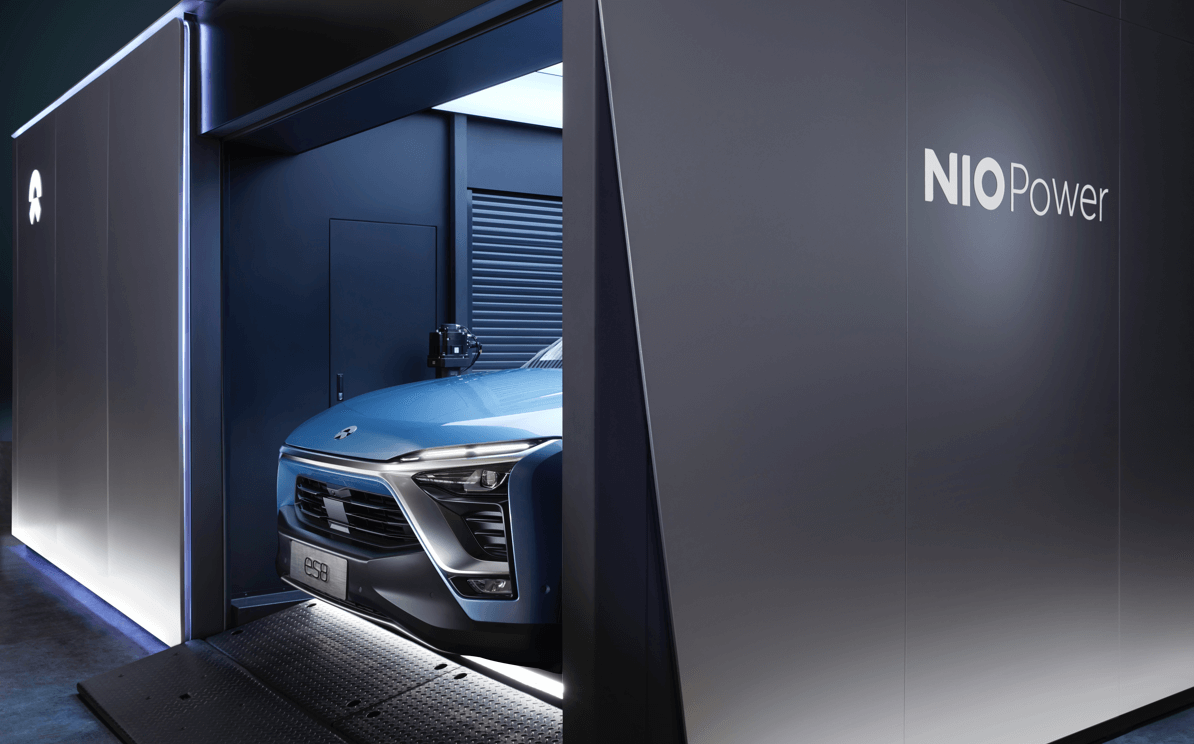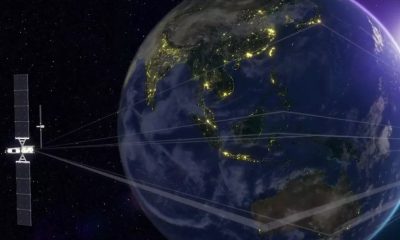

News
NIO’s electric car battery swapping station looks to pick up where Tesla left off
NIO continues to push forward on battery swapping technology that’s aimed at getting its electric cars fueled up in less time than it takes to pump gasoline into a standard internal combustion engine vehicle. NIO owners can use the company’s compact battery swapping stations located in parking lots and other locations for a delay-free power supply for their vehicles. Drivers enter a swap station and wait while an autonomous robot removes a vehicle’s drained battery and replaces it with a completely charged one. With such an option available for quick access to EV power, NIO clearly intends to embrace customer convenience as part of its plan to win over its target customer base.
According to NIO’s IPO last year, this battery exchange service – called “Power Swap” – has been rolled out in nine cities around China, including Beijing and Shanghai. Plans call for 40 to 80 swap stations in place by the end of December. The company announced the completion of its battery swap network along the Chinese G2 Expressway (from Beijing to Shanghai) in early January this year.
NIO is offering a subscription model that’s priced at $200 per month wherein customers can utilize company-provided batteries rather than owning the actual battery that’s attached to their vehicle. If a customer doesn’t own the battery, swapping it out is a mere formality rather than a question of whether their replacement battery is the same quality as the one given up after purchase.


Despite its advantages, NIO’s battery swap plan has given investors pause, and for good reason. This style of recharging concept has gained some closet skeletons in the recent past, particularly via Better Place, the Israeli-based electric car company that gained a pie-in-the-sky reputation trying to become what Tesla ultimately became but went bankrupt instead. Better Place was known for its swap stations, thus wrapping the entire autonomous recharging solution in with Better Place’s downfall, fair or not. The current environment for EVs might change investors’ tune in the near future, though, especially given NIO’s native country’s push for companies just like theirs to exist.
NIO and other electric companies have a unique position with the Chinese government that may help them succeed where others have struggled or failed. Namely, government-driven subsidies and charging infrastructure investments have been offered to China’s customers to encourage the speedy production and expansion of electric car presence. This direct support could be key to NIO’s ability to scale up and profit from its battery swapping business. That, and Tesla’s incredible impact on the demand for electric vehicles and proven ability to implement battery charging networks to ease range anxiety deserves a significant effort.
Tesla has given its own attempt at battery swapping a shot after first demonstrating the capability shortly after Better Place closed up shop. A battery swapping station opened up near the Harris Ranch Supercharger station in Coalinga, CA with appointments available beginning in 2014 as a pilot program. The station appeared to be closed as of 2016, however, and Tesla has only shown an interest in offering the service again via a 2017 patent application for a battery swapping technology after investing its primary resources into developing its Supercharger network. Tesla’s application received a Notice of Allowance for this application from the US Patent and Trademark Office on February 6, 2019, meaning the company has continued to pursue the technology rights and the full patent should issue soon.
NIO opened its doors in 2014 and currently offers two all-electric production vehicles: the ES6 and ES8, both SUVs. Dubbed the “Tesla of China”, the startup successfully delivered 10,000 made-to-order vehicles last year and has made overtaking Tesla in China one of its major goals. Significant investments have been made into branding NIO as a lifestyle company, including exclusive owner clubs and social network opportunities along with customer convenience offerings like the battery swap stations, mobile power vans, and app-based services similar to those offered by Tesla. It remains to be seen whether NIO can successfully revive the battery swap concept, but considering the brave new world of EVs that did not exist a mere few years ago, their hopes certainly don’t seem to be too far fetched.
Watch the below video to see NIO’s battery swapping tech in action:
https://www.youtube.com/watch?v=rmTePwW5HOQ&feature=youtu.be
News
Tesla cleared in Canada EV rebate investigation
Tesla has been cleared in an investigation into the company’s staggering number of EV rebate claims in Canada in January.

Canadian officials have cleared Tesla following an investigation into a large number of claims submitted to the country’s electric vehicle (EV) rebates earlier this year.
Transport Canada has ruled that there was no evidence of fraud after Tesla submitted 8,653 EV rebate claims for the country’s Incentives for Zero-Emission Vehicles (iZEV) program, as detailed in a report on Friday from The Globe and Mail. Despite the huge number of claims, Canadian authorities have found that the figure represented vehicles that had been delivered prior to the submission deadline for the program.
According to Transport Minister Chrystia Freeland, the claims “were determined to legitimately represent cars sold before January 12,” which was the final day for OEMs to submit these claims before the government suspended the program.
Upon initial reporting of the Tesla claims submitted in January, it was estimated that they were valued at around $43 million. In March, Freeland and Transport Canada opened the investigation into Tesla, noting that they would be freezing the rebate payments until the claims were found to be valid.
READ MORE ON ELECTRIC VEHICLES: EVs getting cleaner more quickly than expected in Europe: study
Huw Williams, Canadian Automobile Dealers Association Public Affairs Director, accepted the results of the investigation, while also questioning how Tesla knew to submit the claims that weekend, just before the program ran out.
“I think there’s a larger question as to how Tesla knew to run those through on that weekend,” Williams said. “It doesn’t appear to me that we have an investigation into any communication between Transport Canada and Tesla, between officials who may have shared information inappropriately.”
Tesla sales have been down in Canada for the first half of this year, amidst turmoil between the country and the Trump administration’s tariffs. Although Elon Musk has since stepped back from his role with the administration, a number of companies and officials in Canada were calling for a boycott of Tesla’s vehicles earlier this year, due in part to his association with Trump.
News
Tesla Semis to get 18 new Megachargers at this PepsiCo plant
PepsiCo is set to add more Tesla Semi Megachargers, this time at a facility in North Carolina.

Tesla partner PepsiCo is set to build new Semi charging stations at one of its manufacturing sites, as revealed in new permitting plans shared this week.
On Friday, Tesla charging station scout MarcoRP shared plans on X for 18 Semi Megacharging stalls at PepsiCo’s facility in Charlotte, North Carolina, coming as the latest update plans for the company’s increasingly electrified fleet. The stalls are set to be built side by side, along with three Tesla Megapack grid-scale battery systems.
The plans also note the faster charging speeds for the chargers, which can charge the Class 8 Semi at speeds of up to 1MW. Tesla says that the speed can charge the Semi back to roughly 70 percent in around 30 minutes.
You can see the site plans for the PepsiCo North Carolina Megacharger below.

Credit: PepsiCo (via MarcoRPi1 on X)

Credit: PepsiCo (via MarcoRPi1 on X)
READ MORE ON THE TESLA SEMI: Tesla to build Semi Megacharger station in Southern California
PepsiCo’s Tesla Semi fleet, other Megachargers, and initial tests and deliveries
PepsiCo was the first external customer to take delivery of Tesla’s Semis back in 2023, starting with just an initial order of 15. Since then, the company has continued to expand the fleet, recently taking delivery of an additional 50 units in California. The PepsiCo fleet was up to around 86 units as of last year, according to statements from Semi Senior Manager Dan Priestley.
Additionally, the company has similar Megachargers at its facilities in Modesto, Sacramento, and Fresno, California, and Tesla also submitted plans for approval to build 12 new Megacharging stalls in Los Angeles County.
Over the past couple of years, Tesla has also been delivering the electric Class 8 units to a number of other companies for pilot programs, and Priestley shared some results from PepsiCo’s initial Semi tests last year. Notably, the executive spoke with a handful of PepsiCo workers who said they really liked the Semi and wouldn’t plan on going back to diesel trucks.
The company is also nearing completion of a higher-volume Semi plant at its Gigafactory in Nevada, which is expected to eventually have an annual production capacity of 50,000 Semi units.
Tesla executive teases plan to further electrify supply chain
News
Tesla sales soar in Norway with new Model Y leading the charge
Tesla recorded a 54% year-over-year jump in new vehicle registrations in June.

Tesla is seeing strong momentum in Norway, with sales of the new Model Y helping the company maintain dominance in one of the world’s most electric vehicle-friendly markets.
Model Y upgrades and consumer preferences
According to the Norwegian Road Federation (OFV), Tesla recorded a 54% year-over-year jump in new vehicle registrations in June. The Model Y led the charge, posting a 115% increase compared to the same period last year. Tesla Norway’s growth was even more notable in May, with sales surging a whopping 213%, as noted in a CNBC report.
Christina Bu, secretary general of the Norwegian EV Association (NEVA), stated that Tesla’s strong market performance was partly due to the updated Model Y, which is really just a good car, period.
“I think it just has to do with the fact that they deliver a car which has quite a lot of value for money and is what Norwegians need. What Norwegians need, a large luggage space, all wheel drive, and a tow hitch, high ground clearance as well. In addition, quite good digital solutions which people have gotten used to, and also a charging network,” she said.
Tesla in Europe
Tesla’s success in Norway is supported by long-standing government incentives for EV adoption, including exemptions from VAT, road toll discounts, and access to bus lanes. Public and home charging infrastructure is also widely available, making the EV ownership experience in the country very convenient.
Tesla’s performance in Europe is still a mixed bag, with markets like Germany and France still seeing declines in recent months. In areas such as Norway, Spain, and Portugal, however, Tesla’s new car registrations are rising. Spain’s sales rose 61% and Portugal’s sales rose 7% last month. This suggests that regional demand may be stabilizing or rebounding in pockets of Europe.
-

 Elon Musk2 weeks ago
Elon Musk2 weeks agoTesla investors will be shocked by Jim Cramer’s latest assessment
-

 Elon Musk2 days ago
Elon Musk2 days agoxAI launches Grok 4 with new $300/month SuperGrok Heavy subscription
-

 Elon Musk4 days ago
Elon Musk4 days agoElon Musk confirms Grok 4 launch on July 9 with livestream event
-

 News1 week ago
News1 week agoTesla Model 3 ranks as the safest new car in Europe for 2025, per Euro NCAP tests
-

 Elon Musk2 weeks ago
Elon Musk2 weeks agoA Tesla just delivered itself to a customer autonomously, Elon Musk confirms
-

 Elon Musk1 week ago
Elon Musk1 week agoxAI’s Memphis data center receives air permit despite community criticism
-

 News2 weeks ago
News2 weeks agoXiaomi CEO congratulates Tesla on first FSD delivery: “We have to continue learning!”
-

 Investor's Corner2 weeks ago
Investor's Corner2 weeks agoTesla gets $475 price target from Benchmark amid initial Robotaxi rollout

















